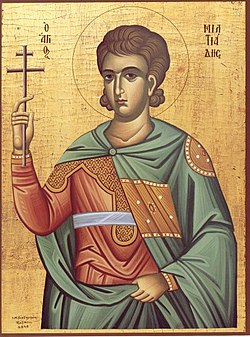Top Qs
Timeline
Chat
Perspective
April 10 (Eastern Orthodox liturgics)
From Wikipedia, the free encyclopedia
Remove ads
Apr. 9 - Eastern Orthodox liturgical calendar - Apr. 11

All fixed commemorations below are observed on April 23 by Eastern Orthodox Churches on the Old Calendar.[note 1]
For April 10th, Orthodox Churches on the Old Calendar commemorate the Saints listed on March 28.
Saints
- Prophetess Huldah (Olda) (IV Kings 22:14)[1][2]
- Martyrs Terence, Africanus, Maximus, Pompeius, and 36 others, including Zeno, Alexander, and Theodore, at Carthage (250)[1][3][4][note 2][note 3] (see also: October 28, March 13, April 5)
- Saint Miltiades, Pope of Rome (314)[1][6][note 4]
- Hieromartyrs James the Presbyter, and the Deacons Azadanes and Abdicius, of Persia (c. 380)[1][7][8]
Pre-Schism Western saints
- Martyrs of Rome (c. 115)[5][note 5][note 6]
- Saint Palladius, Abbot of St Germanus in Auxerre, he became bishop there and founded several monasteries (661)[5]
- Martyrs Beocca, Ethor and others, at Chertsey Abbey, by the Danes (869)[5][10][11][note 7]
- Saint Bede the Younger, a court official who became a monk at the monastery of Gavello near Rovigo (883)[5][12]
- Saint Macarius of Antioch (1012)[5][9][13][note 8]
Remove ads
Post-Schism Orthodox saints
- The Holy Martyrs of Kvabtakhevi Monastery, Georgia, who suffered during the invasion of Tamerlane (1386)[1][14][15]
- Nun-martyr Anastasia, Abbess, and 34 nuns with her, of Uglich (1609)[1][16]
- Venerable martyrs of the Daou Penteli Monastery, in Penteli, by Algerian pirate raiders, (end-17th century)[17][note 9]
- New Martyr George of Cyprus, at Acre, Palestine (1753)[1]
- New Martyr Demos (Demetrios) of Smyrna (1763)[1][19][20][note 10]
- New Hieromartyr Gregory V, Ecumenical Patriarch of Constantinople (1821)[1][20][21][22][note 11]
- Seven Hieromartyr Bishops, arrested together with Ecumenical Patriarch Gregory V, subsequently martyred by the Ottoman Turks at the start of the Greek War of Independence (1821):[24][25][note 12]
- New Monk-martyr Chrysanthus of Xenophontos monastery, Mt. Athos, on Pascha (1821)[1][26]
New martyrs and confessors
Other commemorations
- Consecration of Ioasaph (Bolotov) as Bishop of Kodiak, Alaska (1799)[1]
Icon gallery
- Icon of Saint Miltiades, Pope of Rome.
- Hanging of Patriarch Gregory V of Constantinople.
Notes
- The notation Old Style or (OS) is sometimes used to indicate a date in the Julian Calendar (which is used by churches on the "Old Calendar").
The notation New Style or (NS), indicates a date in the Revised Julian calendar (which is used by churches on the "New Calendar"). - Name days celebrated today include:
- Anaximenes (Ἀναξιμένης); Demosthenes (Δημοσθένης); Epaminondas (Ἐπαμεινώνδας); Eteocles (Ἐτεοκλής); Heracles (Ἠρακλῆς); Theseus (Θησέας); Isocrates (Ἰσοκράτης); Makarios (Μακάριος); Homer (Ὅμηρος); Parmenion (Παρμενίων); Pelopidas (Πελοπίδας); Pericles (Περικλῆς); Polybius (Πολύβιος); Polynikos (Πολύνικος); Prometheus (Προμηθέας); Sophocles (Σοφοκλῆς); Philopoimen (Φιλοποίμην); Fokion (Φωκίων).
- A number of criminals baptised by Pope Alexander during his imprisonment. They were taken to Ostia near Rome and put on board a boat which was then scuttled.
- Born in Antioch, he was a bishop who travelled westwards as a pilgrim and was received by monks at the monastery of St Bavo in Ghent in Belgium.
- The Monastery lies on the eastern slope of Penteli, on the road to Rafina-Pikermi, near a ravine. It is a monastic complex consisting of the katholikon, the cells, the Refectory, a fountain and a Byzantine defense tower in the entrance gate. The Monastery was destroyed in the end of the 17th century by Algerian pirates’ raids, who slaughtered the monks, whose heads and relics are displayed in a building of the monastic complex.[18]
- See also: (in Greek) Νταού Πεντέλης Αττικής. Βικιπαίδεια. (Greek Wikipedia).
- "The holy patriarch-martyr was hanged over the door to the Phanarion and later his body was thrown into the Bosphoros. Ukrainian sailors retrieved his body, thinking him to have been a priest martyred by the Turks. At Odesa, he was positively identified as the patriarch and enshrined there until his glorification as a sainted hieromartyr and return to Athens where he is now enshrined. The Ukrainian Orthodox Church has placed his name in its own calendar, especially owing to his great veneration by Ukrainians. The translation of his relics took place on 25/4/1871."[23]
- On the occasion of the two hundred years since the martyrdom of Patriarch Gregory I on 10 April 1821, with the recommendation of the Accompanying Committee on Legal and Doctrinal Issues, and on the proposals of the Most Reverend Metropolitans Chrysostomos of Patras, Theophilos of Lefkados and Ithaca, and Markos of Chios, Psara and Oinousses, the Permanent Holy Synod of the Church of Greece decided to inscribe in the hagiological lists of the church seven other hierarchs who were arrested together with Patriarch Gregory V on the same day, and were subsequently hanged, confessing the faith.[24][25]
- See also: (in Greek) Ευγένιος Καραβίας. Βικιπαίδεια. (Greek Wikipedia).
- See also: (in Greek) Ιωσήφ Αντωνόπουλος. Βικιπαίδεια. (Greek Wikipedia).
- See also: (in Greek) Γρηγόριος ο Δέρκων. Βικιπαίδεια. (Greek Wikipedia).
- See also: (in Greek) Διονύσιος Καλλιάρχης. Βικιπαίδεια. (Greek Wikipedia).
- See also: (in Greek) Δωρόθεος Πρώιος. Βικιπαίδεια. (Greek Wikipedia).
- See also: (in Greek) Αθανάσιος Νικομηδείας. Βικιπαίδεια. (Greek Wikipedia).
- See also: (in Bulgarian) Йоаникий Търновски. Уикипедия. (Bulgarian Wikipedia).
- See: (in Russian) Понгильский, Флегонт Николаевич. Википедии. (Russian Wikipedia).
Remove ads
References
Sources
Wikiwand - on
Seamless Wikipedia browsing. On steroids.
Remove ads


